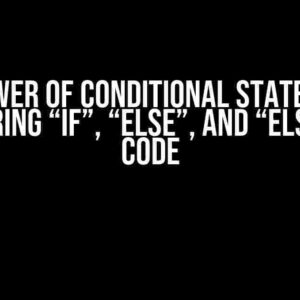Regular Expressions (regex) are a powerful tool for matching and manipulating text patterns. One of the most useful aspects of regex is grouping, which allows you to capture specific parts of a pattern and use them later in your code. In this article, we’ll dive deep into the world of grouping text with regex, covering the basics, advanced techniques, and providing real-world examples to help you master this essential skill.
What is Grouping in Regex?
In regex, grouping refers to the ability to enclose a pattern in parentheses, allowing you to treat it as a single unit. This enables you to capture specific parts of a match and reference them later in your code. Grouping is essential for tasks such as extracting data from text, validating user input, and performing complex text manipulations.
The Basics of Grouping
To create a group in regex, simply enclose your pattern in parentheses. For example, the regex pattern `(hello)` matches the literal string “hello” and captures it as a group. You can then reference this group in your code using the `$1` syntax.
const regex = /(hello)/;
const str = 'hello world';
const match = str.match(regex);
console.log(match[1]); // Output: "hello"
In this example, the regex pattern `(hello)` creates a single group that matches the literal string “hello”. The `match` array returned by the `match()` method contains the entire match, followed by each captured group. In this case, `match[0]` would contain the entire match (“hello world”), while `match[1]` contains the captured group (“hello”).
Types of Groups
Regex offers several types of groups, each with its own unique characteristics and use cases.
Capturing Groups
Capturing groups are the most common type of group in regex. They capture a part of the match and allow you to reference it later in your code.
const regex = /(hello|hi) (world)/;
const str = 'hello world';
const match = str.match(regex);
console.log(match[1]); // Output: "hello"
console.log(match[2]); // Output: "world"
In this example, the regex pattern `(hello|hi) (world)` creates two capturing groups. The first group matches either “hello” or “hi”, while the second group matches “world”. The `match` array contains the entire match, followed by each captured group.
Non-Capturing Groups
Non-capturing groups are similar to capturing groups, but they do not create a capture that can be referenced later in your code. They are useful for grouping patterns without creating a capture.
const regex = /(?:hello|hi) (world)/;
const str = 'hello world';
const match = str.match(regex);
console.log(match[1]); // Output: "world"
In this example, the regex pattern `(?:hello|hi) (world)` creates a non-capturing group using the `(?:)` syntax. The first group matches either “hello” or “hi”, but it does not create a capture. The second group matches “world” and is captured as `match[1]`.
Advanced Grouping Techniques
Now that you’ve mastered the basics of grouping, it’s time to explore some advanced techniques to take your regex skills to the next level.
Nested Groups
Nested groups allow you to create complex patterns by grouping multiple patterns together.
const regex = /((hello|hi) (world))/;
const str = 'hello world';
const match = str.match(regex);
console.log(match[1]); // Output: "hello world"
console.log(match[2]); // Output: "hello"
console.log(match[3]); // Output: "world"
In this example, the regex pattern `((hello|hi) (world))` creates a nested group. The outer group captures the entire match, while the inner group captures either “hello” or “hi”, and another group captures “world”.
Named Groups
Named groups allow you to assign a name to a group, making it easier to reference and use in your code.
const regex = /(?<greeting>(hello|hi)) (?<target>world)/;
const str = 'hello world';
const match = str.match(regex);
console.log(match.groups.greeting); // Output: "hello"
console.log(match.groups.target); // Output: "world"
In this example, the regex pattern `(?
Real-World Examples
Now that you’ve learned about the various types of groups and advanced techniques, let’s explore some real-world examples of grouping text with regex.
Extracting Data from Text
Suppose you have a string containing user data in the format “Name: John Doe, Age: 30, Email: [email protected]”. You can use grouping to extract the individual data points.
const regex = /Name: (?<name>[^,]+), Age: (?<age>\d+), Email: (?<email>[^\s]+)/;
const str = 'Name: John Doe, Age: 30, Email: [email protected]';
const match = str.match(regex);
console.log(match.groups.name); // Output: "John Doe"
console.log(match.groups.age); // Output: "30"
console.log(match.groups.email); // Output: "[email protected]"
In this example, the regex pattern `Name: (?
Validating User Input
Suppose you need to validate a user’s input against a specific pattern, such as a phone number in the format “(123) 456-7890”. You can use grouping to capture the individual parts of the pattern.
const regex = /^\(?(<areaCode>\d{3})\)? ?(<exchange>\d{3})-(<lineNumber>\d{4})$/;
const str = '(123) 456-7890';
const match = str.match(regex);
console.log(match.groups.areaCode); // Output: "123"
console.log(match.groups.exchange); // Output: "456"
console.log(match.groups.lineNumber); // Output: "7890"
In this example, the regex pattern `^\(?(?
Conclusion
Grouping text with regex is a powerful technique that allows you to capture and manipulate specific parts of a pattern. By mastering the basics of grouping, including capturing and non-capturing groups, and advanced techniques like nested groups and named groups, you can tackle complex text manipulation tasks with ease. Remember to practice and apply your knowledge to real-world examples to become proficient in regex.
| Type of Group | Description | Example |
|---|---|---|
| Capturing Group | Creates a capture that can be referenced later in your code | (hello|hi) |
| Non-Capturing Group | Groups patterns without creating a capture | (?:hello|hi) |
| Nested Group | Groups multiple patterns together | ((hello|hi) (world)) |
| Named Group | Assigns a name to a group for easy referencing | (?<greeting>(hello|hi)) |
By following the examples and explanations in this article, you’ll be well on your way to becoming a regex master. Remember to practice regularly and apply your knowledge to real-world scenarios to solidify your skills.
- Regex is a powerful tool for matching and manipulating text patterns.
- Grouping allows you to capture specific parts of a pattern and reference them later in your code.
- There are several types
Frequently Asked Question
Get clarity on grouping text with regex with these frequently asked questions!
What is grouping in regex and how does it work?
In regex, grouping allows you to treat a part of the pattern as a single unit. This is achieved by enclosing the pattern in parentheses `()`. The text matched by the group can then be retrieved later in the pattern or in the replacement string. Think of it like creating a container for a specific part of the text, allowing you to manipulate it separately.
How do I specify a group in regex?
To specify a group, simply enclose the pattern you want to group in parentheses `()`. For example, the pattern `(abc)` would match the string “abc” as a single unit. You can also give a name to your group by using the syntax `(?
pattern)`, which can make your regex pattern more readable and maintainable. What is a capture group in regex?
A capture group is a group in regex that remembers the matched text, allowing you to reference it later in the pattern or in the replacement string. Capture groups are numbered based on the order of their opening parentheses, with the first group being group 1, the second group being group 2, and so on.
How do I access a capture group in regex?
You can access a capture group in regex by using backreferences. A backreference is a way to reference a capture group in the pattern or replacement string. For example, the syntax `\1` would refer to the first capture group, `\2` would refer to the second capture group, and so on.
What is a non-capturing group in regex?
A non-capturing group is a group in regex that does not remember the matched text. Non-capturing groups are specified using the syntax `(?:pattern)`. They are useful when you want to group a pattern for organizational purposes, but you don’t need to reference the matched text later.





